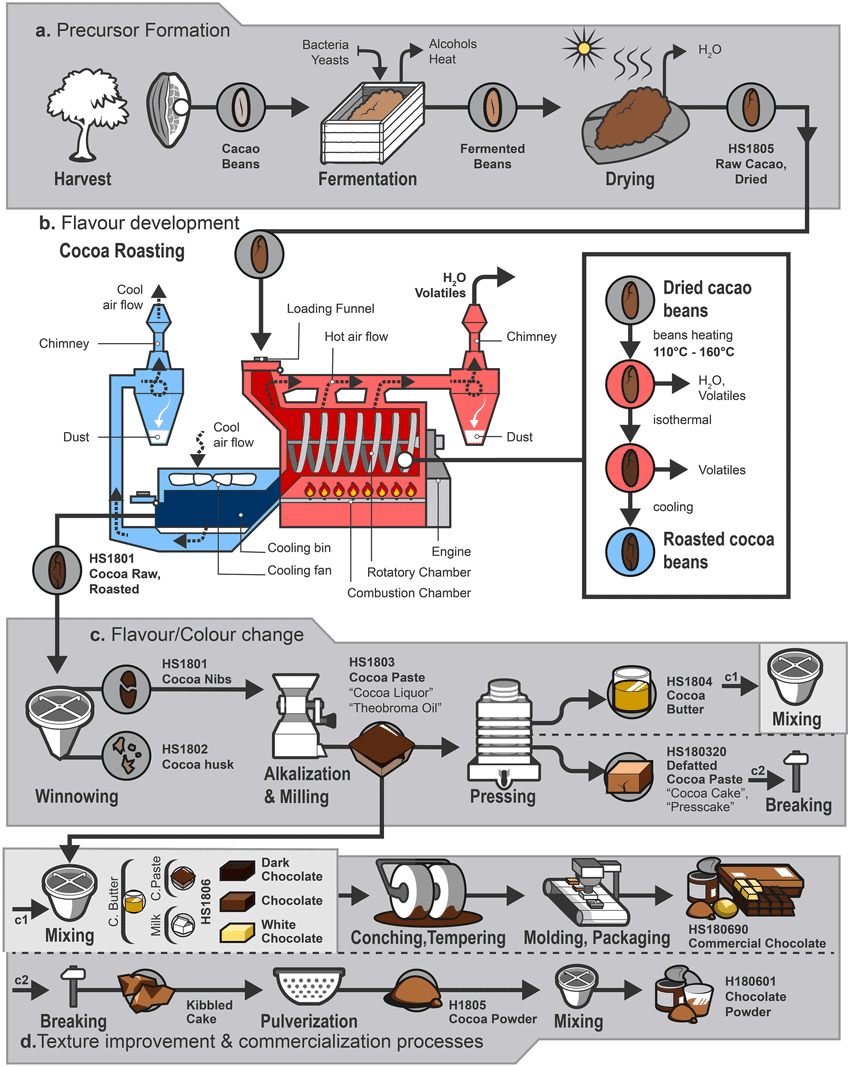Chocolate has been around for thousands of years. While I can’t imagine how chocolate could get much better, chocolate makers are still experimenting with ways to make new types and flavors of chocolate to keep our taste buds excited. Now, a new way of processing cocoa beans has been published in Journal of Food and Agricultural Chemistry. Could our favorite food about to be improved by science?
So how is chocolate made?
In the conventional process, cocoa beans are harvested, traditionally covered with banana leaves, and allowed to ferment. During this time, microbes break down the pulp surrounding the beans, heating and acidifying them. This process is important as the biochemical changes that occur in the beans reduce bitterness and astringency, and help develop the flavors and aromas we associate with chocolate. However, this traditional mode of fermentation can be difficult to control and takes several days.
To make chocolate, the beans are roasted, shelled (avetan) and then ground into a cocoa paste. This paste is then pressed and separated into cocoa butter and defatted cocoa paste. The defatted cocoa paste is then pulverized into cocoa powder. All chocolate contains cocoa butter, but to make different types of chocolate, some key ingredients are modified. Dark chocolate contains sugar and cocoa powder. Adding milk makes it milk chocolate. Skipping the cocoa powder creates white chocolate. A fourth type of chocolate, called ruby chocolate, is made in a similar way to white chocolate but uses unfermented cocoa beans, which retain their pink hues.

So what does “wet incubation” chocolate taste like?
But does the new method pass the taste test? A group of sensory panelists (and yes, this is genuine work) tasted chocolate bars made through the new method of wet incubation, traditional fermentation, and also unfermented beans as a control. The wet-incubated chocolate had higher intensities of “fruity, floral, malty and caramel” aromas than traditional fermented chocolate, which had more “roasty” notes. Chocolate made from unfermented beans had a primarily “green” aroma. The wet-incubated samples also scored highest for sweetest flavor, while unfermented chocolate was the most bitter and astringent.
Aromatic compounds were identified by gas chromatography (GC)-olfactometry, which extracts and separates individual aromatic compounds, and quantified by gas chromatography-mass spectrometry (GC-MS), which measures the levels of separated chemical compounds. This confirmed the presence of higher levels of malty compounds called Strecker aldehydes and lower levels of roasting compounds called pyrazines in wet-incubated chocolate compared to traditionally fermented chocolate.
In a boon to sweet snack lovers the world over, using this faster and better-controlled “wet incubation” process to ferment cocoa beans can produce high-quality chocolate with non-traditional yet pleasing aromas and flavors. . The researchers suggest that producing chocolate with a naturally sweeter taste means less sugar needs to be added. It is not yet a healthy food, but we are sure that science will not stop trying.

Read science facts, not fiction…
There has never been a more important time to explain the facts, appreciate evidence-based knowledge, and showcase the latest scientific, technological, and engineering advances. Cosmos is published by The Royal Institution of Australia, a charity dedicated to connecting people with the world of science. Financial contributions, large or small, help us provide access to reliable scientific information at a time when the world needs it most. Please support us by making a donation or purchasing a subscription today.
